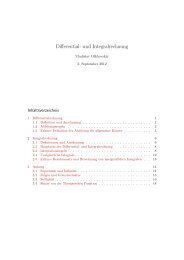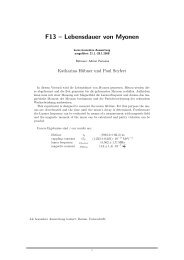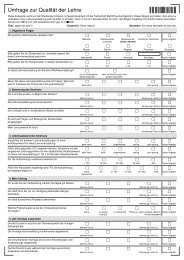Extrasolar Moons as Gravitational Microlenses Christine Liebig
Extrasolar Moons as Gravitational Microlenses Christine Liebig
Extrasolar Moons as Gravitational Microlenses Christine Liebig
You also want an ePaper? Increase the reach of your titles
YUMPU automatically turns print PDFs into web optimized ePapers that Google loves.
CHAPTER 2. GRAVITATIONAL LENSING 9<br />
distances covered by the light path are very large in comparison to the extent of<br />
m<strong>as</strong>s distribution of the lens.<br />
DS<br />
I2<br />
DLS<br />
DL<br />
L<br />
O<br />
β<br />
θ<br />
η S I1<br />
Figure 2.1: Sketch of a gravitational<br />
lensing system. Notation<br />
is explained in the text.<br />
ξ<br />
α<br />
˜α<br />
In figures 2.1 and 2.2 the relevant parameters<br />
of point-m<strong>as</strong>s lensing are sketched. I1 and I2<br />
denote the apparent locations of the two images<br />
of the source S. There are always images for a<br />
point m<strong>as</strong>s lens L and a single source S (compare<br />
equation (2.2) and its derivation below), except<br />
for the singular c<strong>as</strong>e of perfect alignment, when<br />
an Einstein ring is visible. The observer O sits in<br />
the observer plane. The hyperbolic light paths<br />
are approximated by two straight rays with a<br />
sharp bend at the lens plane in figure 2.1.<br />
General relativity predicts that a light ray,<br />
which p<strong>as</strong>ses by a point m<strong>as</strong>s M at a minimum<br />
distance ξ, is deflected by an angle<br />
ˆα = 4GM<br />
c2 . (2.1)<br />
ξ<br />
G denotes the <strong>Gravitational</strong> constant, c the speed<br />
of light. The point m<strong>as</strong>s is a safe approximation<br />
for a Galactic lensing situation, where two stars<br />
align to form a gravitational lens system. It is<br />
justified to approximate the lensing body <strong>as</strong> a<br />
point m<strong>as</strong>s or point lens under the <strong>as</strong>sumption<br />
that all light rays p<strong>as</strong>s at a distance from the centre of m<strong>as</strong>s, which is larger than<br />
the radius of the lensing star.<br />
Considering simple geometry in figure 2.1 we find the lens equation<br />
βDS = θDS − ˜αDLS<br />
for θ, β, ˜α










